#hoodwinker sunfish
Explore tagged Tumblr posts
Text
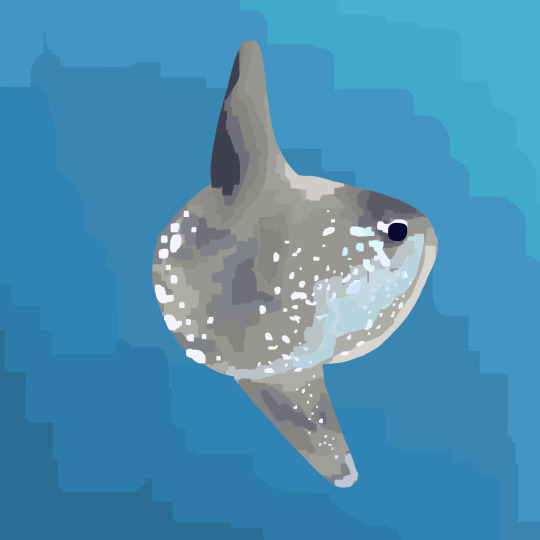

ok day 13 is big fish and i couldnt decide so hoodwinker sunfish (I LOVE SUNFISH!!! I LOVE SUNFISH) and my attempt at a coelacanth!!!
#teehee#i think they turned out cute#coelacanth is pretty big..#art#drawing#digital art#marine life#marine animals#marine biology#coelacanth#mola mola#sunfish#hoodwinker sunfish#fishuary2024
660 notes
·
View notes
Photo

Mola mola. The mola we all knowla. The mola we all molove. What an incredible creature, Mola mola is! Such a strange shape, so many eggs, no swim bladder... and the size. Its most prized aspect! If you know one thing about Mola mola, it’s that it is the largest bony fish, right?
...Right?
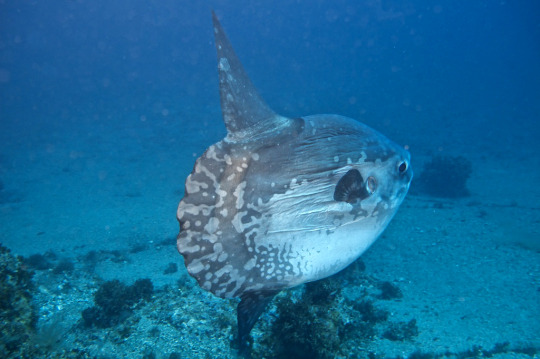
Nuh-uh-uh, Mola mola. Don’t try and sneak away. It’s very noticeable. After all, you are one of the biggest bony fish!
Let me repeat that. One of the biggest bony fish.
Mola mola, the ocean sunfish, is NOT in fact the largest known bony fish! You’d think we were talking about Mola tecta, because this sunfish has hoodwinked us!
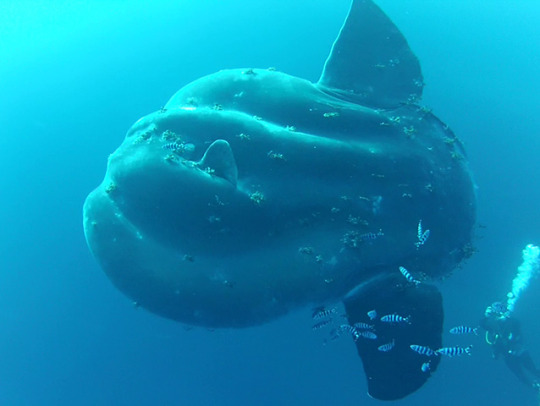
Behold MOLA ALEXANDRINI! Known, very appropriately, as the giant sunfish. This is the true heaviest bony fish! Not Mola mola, as has so been thought, and as I have even claimed in front of all of you. I was wrong! Mola alexandrini has been recorded weighing up to 6,049 pounds, with Mola mola trailing in the measly little 2,000s range. But if Mola alexandrini can be so much bigger, how was Mola mola seen as the champion for so long?
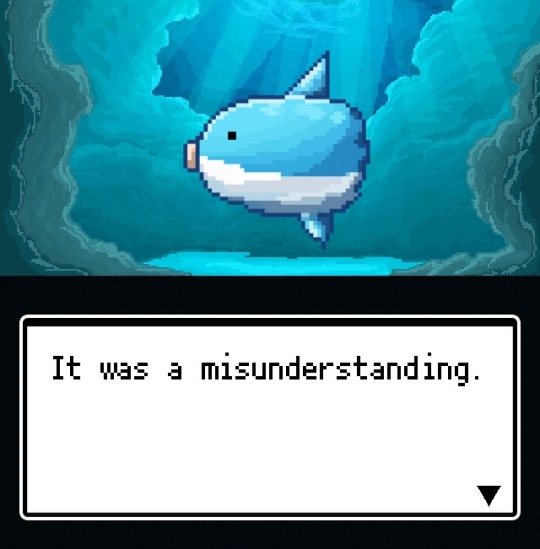
It was a misunderstanding. A misidentification! That huge specimen was caught all the way back in 1996, but thought to be Mola mola until it was reevaluated in 2017! Members of the Mola genus are just always accidentally tricking us humans. I’m sure they would say “sooorry” in a deep and booming, yet slow and gentle voice if they knew.
So how can you #KnowYourMolas? It is easy to confuse them- even scientists do it- but generally, be sure to notice the shapes of both the face and the clavus (the funny butt fin)! If the face is relatively smooth, and especially if the clavus has a scalloped shape, that’s Mola mola. If the face is bulgy and bumpy and the clavus is smooth and round, that’s Mola alexandrini! And if the face is smooth but the clavus is too, then you have been hoodwinked by Mola tecta!
So there you have it. The truth about the Mola mola! Not the biggest after all... but that does not matter to me. Mola mola will always be my favorite! That being said, please show Mola alexandrini some love too, as despite its size, it is still a lesser known Mola!
And who knows? Maybe even alexandrini will be dethroned! Maybe we will find a bigger alexandrini, or maybe a bigger mola! Maybe even a different species altogether is the true largest bony fish! There is no way to know what the future has in store... so many secrets in the ocean!
Refer here for more information on the updated identification!
#mola mola#mola alexandrini#mola tecta#molidae#mola#ocean sunfish#giant sunfish#hoodwinker sunfish#april fools#not mario#fish#mod chikako
2K notes
·
View notes
Text

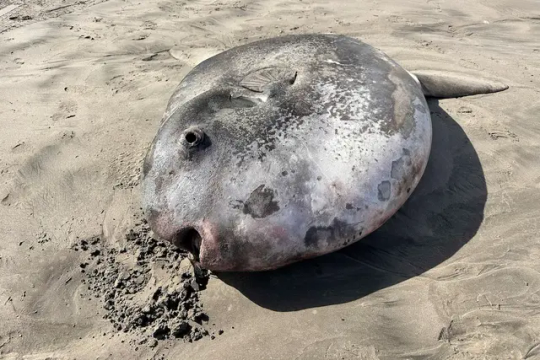
What's this? The seven-foot-long hoodwinker sunfish that washed up on a beach in Oregon. Big and bizarre, right?
69 notes
·
View notes
Text
Official molidae post:

we made festive cookies.
#official molidae post#ocean sunfish#molidae#art#sunfish#mola alexandrini#mola mola#masturus lanceolatus#mola tectus#ranzania laevis#common sunfish#giant sunfish#sharptail sunfish#hoodwinker sunfish#slender sunfish#christmas cookies#sugar cookies
28 notes
·
View notes
Text
Daily fish fact #458
Hoodwinker sunfish!

This species was only found very recently, as it was mistaken for other ocean sunfishes! Its scientific name, Mola tecta, references that, as "tecta" comes from the Latin word "tectus" which means hidden or disguised. However, it is distinguishable from other species as it is slimmer and lacks a lot of the "lumpiness" some of the other species have.
#mwahaha! another ocean sunfish fact! i am unstoppable!#fish#fishfact#fish facts#fishblr#marine biology#marine life#marine animals#sea creatures#sea animals#sea life#biology#zoology#hoodwinker sunfish#sunfish#mola tecta#oh and by ocean sunfish i literally mean sunfish that is found in the ocean! “ocean sunfish” of course means the mola mola#i wanted to distinguish between freshwater and saltwater sunfish because theyre completely different but i now see how that tag could be-#read wrong whoops
366 notes
·
View notes
Text
Rare 7-foot hoodwinker sunfish washed ashore on Oregon’s coast
A rare hoodwinker sunfish, typically found in the southern hemisphere, surprises beachgoers in Oregon by washing up on the northern coast. Measuring 7.3 feet, the massive fish draws crowds in Gearhart, remaining on the beach for days due to its tough skin. Cover Photo: YouTube Read More LM News Unusual scary-looking fish washes up in Singapore beach The hoodwinker Photos reveal its imposing…

View On WordPress
0 notes
Text
Wet Beast Wednesday: ocean sunfish
Everybody knows ocean sunfish, right? Those giant, slow, silly-looking, parasite-ridden morons that eat jellyfish and can't defend themselves from predators really are the worst fish right?

(GIF: Lex Luthor screaming "WRONG!" from the movie Superman Returns)
First of all there's no such thing as a "best" or "worst" animal and judging animals by human standards of what is cool or successful is silly because our standards are not even universal among humans, let along other species. Secondly, the closest thing we have to a way to judge a species is how successful it is in its niche and sunfish are doing pretty good, thank you very much. Today I'll be talking about sunfish and how they are not bad fish at all.
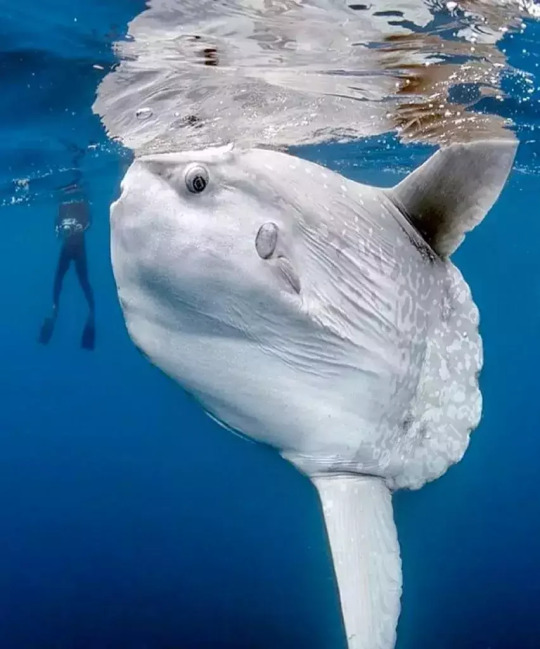
(Image: a Mola mola located near the surface of the ocean, with the tip of its dorsal fin and part of its head breaching the surface. It is a round fish with no tail, only a wrinkly region of its body. Its dorsal and anal fins are long and slender The eyes and mouth are proportionately small. It is a pale white with light grey spots. A SCUBA diver is visible in the background. End ID)
Ocean sunfish, or molas, are members of the family Molidae, which is divided into five known species across three genuses. Im mostly going to be talking about members of the genus Mola, but I'll mention the other two as well. Molas are known for their size and odd appearances, looking like someone chopped a fish in half and the front half went swimming off on its own. They are members of the order Tetraodontiformes, making them cousins to pufferfish, triggerfish, boxfish, and others. While many members of that order are known to be highly poisonous, molas are not. They also lack several other common traits. Despite being bony fish, most of the mola skeleton is made of cartilage and they do not have swim bladders, forcing them to actively swim to maintain their position in the water column. Instead of a tail and caudal fin, sunfish have a structure called the clavus. The clavus is formed mostly from connective tissue and is used as a rudder. Because the clavus is mostly made of connective tissue, damage to it is not particularly harmful to the fish. There have been molas found alive and well that have had portions of their clavus eaten by predators. Because of their shortened stature, molas have the fewest vertebrae of all fish. The dorsal and anal fins are elongated and are used to provide propulsion by flapping back and fourth similarly to how birds wings move, albeit slower. Minute alterations in the angle each fin moves through the water help with steering, while more sharp turns are aided with jets of water ejected through the mouth and gills. Like their other Tetraodintid relatives, mola teeth are fused together into a beak-like structure that prevents them from closing their mouths. They also have some more regular pharyngeal teeth in the backs of their mouths. Some reports say that the fish can make noises by grinding the pharyngeal teeth together. Mola skin is thick and rough, described as being similar to sandpaper in texture. Like most fish, the skin is covered in a layer of protective mucus.

(Image: a mola sunbathing. It is positioned with one side of its body facing the surface. Its body is just under the water's surface. End ID)
The three species in the genus Mola are Mola mola, the ocean sunfish and most well-known of the molas, Mola alexandrini, the giant, southern, or bumphead mola, and Mola tecta, the hoodwinker sunfish. Mola mola has an average weight of 247 to 1000 kg (545 to 2205 lbs), mouth to clavus length of 1.8 m (5.9 ft) and dorsal to anal fin length of 2.5 m (8.2 ft), though some individuals can get much large. The largest individual on record had a length of 3.3 m (10.8 ft), height of 3.2 m (10.5 ft) and weighed 2300 kg (5100 lbs). M. alexandrini is the largest of the species. The largest known southern sunfish measured in at 2744 kg (6049 lbs) and 3.25 m (10.66 ft) from mouth to clavus, making it the largest known bony fish in the world. They can be distinguished from M. mola by the presence of bumps on the forehead and chin, a more rounded clavus, and differently-shaped scales. M. tecta is known as the hoodwinker sunfish because it was long mistaken for one of the other two species and was only identified as a separate species in 2015 after the body of one washed up in Christchurch, Aotearoa/New Zealand and was examined by scientists. Because it has only recently been discovered, little is known about this species. They appear to have the same range of sizes and weights of the other two species and can be distinguished by a slimmer body shape and a smooth clavus. All three species are found in tropical and temperate waters worldwide, though M. alexandrini and M. tecta are more commonly found in the southern hemisphere.
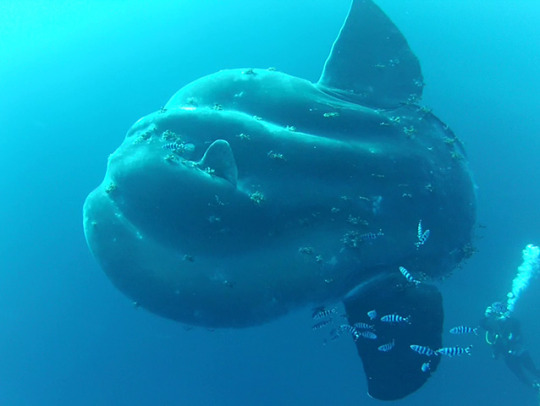
(Image: a Mola alexandrini underwater. It is distinguishable from Mola mola by the two bumps above and below its facial region, making it look lumpy. It is surrounded by striped cleaner fish. A SCUBA diver is in the background. End ID)
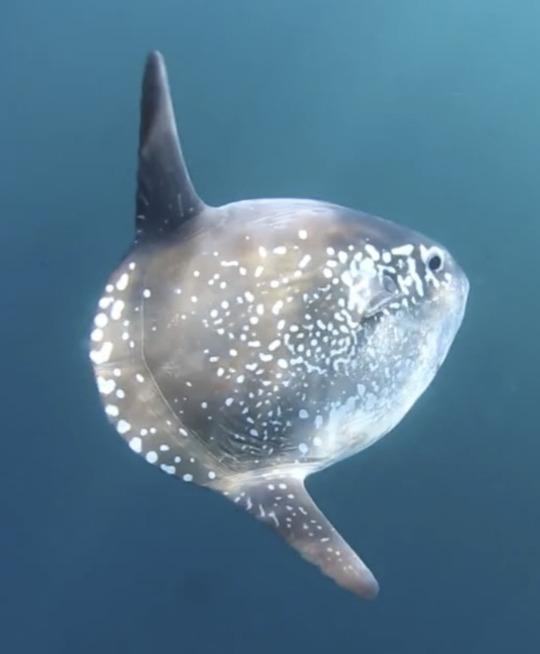
(Image: a Mola tecta seen from the side. It is smoother than the other two species. More of its body is grey with white spots. End ID)
Molas are open-ocean dwellers that live life in the slow lane. For a long time, it was believed they were moved around by ocean currents they could not swim against, making them plankton. We now know they not only can swim against the current, they are capable of bursts of speed fast enough to breach the water's surface and briefly go airborne. Sunfish are named for their habit of basking at the surface of the water. It was formerly believed they spent most of their time at the surface, but thanks to tagging, we know they make frequent dives into the deep ocean. They likely bask at the surface to warm up between dives. You may not expect something as slow as a sunfish to be a predator, but they are. Much of their diet consists of gelatinous animals including jellyfish, siphonophores, ctenophores, and salps, though they will also eat small fish, fish larvae, squids, crustaceans, and even seagrass. Because they can't chew, sunfish move prey into and out of their mouth by rapidly switching between sucking water in and spitting it out in order to shred the prey into pieces small enough to swallow. Special mucus lining the digestive system may protect the molas from the stinging tentacles of their prey. Molas and other jellyfish-eaters like the leatherback sea turtle play an important role in the ecosystem by keeping jellyfish populations down. Jellyfish are not particularly nutritious, so the sunfish need to eat a lot of them to survive, something they seem to be pretty good at. Being slow and having a very low-energy lifestyle helps the fish survive on a less-nutritious diet, making them very energy efficient. One thing molas get a lot of flack for online is having lots of parasites (with up to 40 known species). This doesn't really make sense. Every species has parasites. An animal in the wild that doesn't have parasites is vanishingly rare. Having parasites doesn't make an animal suck, it makes them ordinary. Because of their parasite load, molas are frequent visitors to cleaner fish, who will eat their parasites. Molas will also let seabirds land on them and eat their parasites while they rest on the surface. The molas attract birds by splashing at the surface. Adult molas have few natural predators, but are hunted by sharks, sea lions, and orcas. Interestingly, sea lions have been known to kill molas apparently for sport, ripping off the fins and then leaving the mola to die.

(Image: a mola seen from the front. Multiple smaller fish are picking parasites off of its skin. End ID)
Molas are broadcast spawners who release their gametes into the water alongside each other. A female mola can release 300 million eggs at a time, more than any other vertebrate. Newly hatched sunfish are 2.5 millimeters long and are often cited as having the largest discrepancy in size between juvenile and adult of any vertebrate. An adult mola can be 60 millions times the weight of a larva. The larvae look very different than adult, lacking their dorsal and anal fins but having pufferfish-like spines. Juveniles school together for protection and become solitary as they age. The diet of the fish varies as they age, with younger fish feeding more on squid, worms, crustaceans, and fish but becoming more reliant on jellyfish and other gelatinous prey as they age. We don't know the growth rate of molas, but a juvenile in the Monterey Bay Aquarium grew from 26 to 339 kg (57 to 880 lbs) in 15 months, suggesting they grow rapidly. The maximum age of molas is unknown, though individuals in captivity have lives for up to 10 years.

(Image: a mola larva. It is a brown ball with large, black eyes and no visible fins. It is covered in transparent, conical spines. End ID)
The two non-Mola sunfish are Ranzania laevis, the slender sunfish and Masturus lanceolatus, the sharptail sunfish. Both are alone in the genuses, but other species are suspected. I also found references to other species in Masturus, but could find literally no information about them other than that Masturus oxyuropterus is listed in some records. The sharptail sunfish looks very similar to Mola mola and reaches similar sizes, but its clavus has an extension that looks like a short tail. They were initially believed to be deformed molas before being recognized as a separate species. Unlike molas, sharptail sunfish are rarely seen at the surface, preferring to stay in deeper water. The slender sunfish is the smallest of the family, reaching up to a meter long. While we don't know much about them, we know their diet includes a lot of fast-moving squid, indicating they can move faster than their much larger relatives.
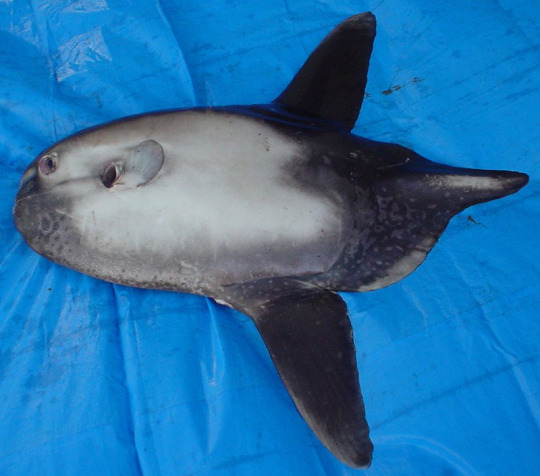
(Image: a sharptail sunfish lying on a blue tarp. It looks similar to a Mola mola , but with black clavus and fins. At the back of the clavus is a triangular extension. End ID)
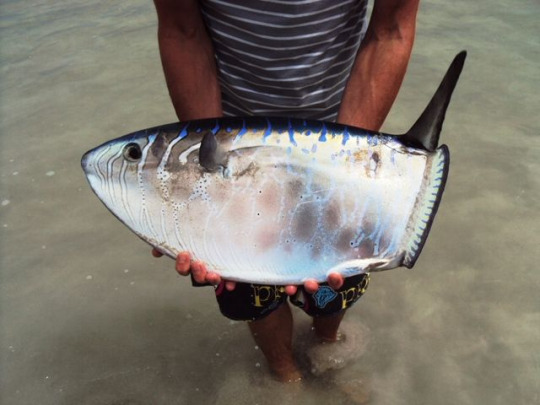
(Image: a person holding a slender sunfish. The fish is small enough to be held and has a longer and skinnier body than other sunfish. Its body is a shiny silver with blue lines. End ID)
Mola mola is classified as vulnerable by the IUCN while the other species are classed as either data deficient or least concern. Molas are vulnerable to strikes by boats and bycatch. Another danger to them is plastic bags, which can easily be ingested after being mistaken for a jellyfish. The bags can suffocate the fish or block their digestive tracts. Despite their size, molas are docile and not dangerous to humans. I found one example of a mola harming a human and it happened when the fish jumped out of the water and landed on a boat. Allegedly, some fish have learned to recognize and approach SCUBA divers. Molas are difficult to keep in captivity due to their size, the amount of space the need, and special feeding needs, so only a few aquariums have them. Molas are captured for food, with the biggest markets being in Taiwan and Japan, where they are often called mambos.
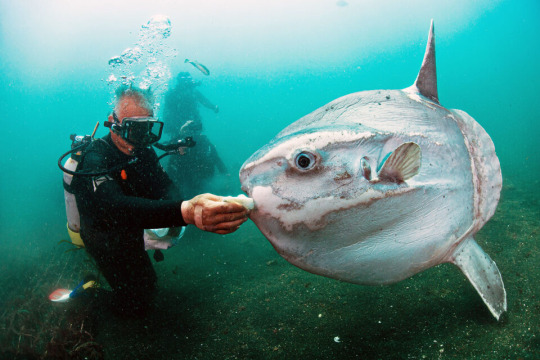
(Image: a SCUBA diver attempting to hand feed a small mola. End ID)
#wet beast wednesday#ocean sunfish#mola mola#name so nice you say it twice#countering sunfish slander#mola alexandrini#mola tecta#sharptail mola#Masturus lanceolatus#slender sunfish#Ranzania laevis#fish#fishblr#fishposting#marine biology#biology#zoology#ecology#animal facts#image described
211 notes
·
View notes
Note
Freebie!
Tell me something you've been dying for someone to ask you about
i see youve asked about my current favorite fish, im always itchin to tell people about the fish of the day
Mola Tecta!!! aka the hoodwinker sunfish
this is thee most recently discovered ocean sunfish (2015!!!), and not because they are particularly elusive or shy, but because they look.

almost exactly the same as Mola Mola
8 notes
·
View notes
Note
tell me about the sunfish
OH BOY DO YOU KNOW HWAT YOU HAVE DONE??? HERE I GO:
(IDs in alt text.)

So there's this family of fish called molidae, yeah? and in molidae there's three families, Mola, Masturus, and Ranzania, and five species.
All of them have weirdo tails, in that their tails are like, gone. Their caudal fin is very stunted and used like a rudder, while anal and dorsal are used to propel. See below.


That's a Mola alexandrini and Mola tecta (drawn by yours truely), aka gian sunfish and hoodwinker sunfish! Molidae start their life as teeny tiny larva only a few cells large, and only a few of the thousands eggs released make it to adulthood. Molas are also the largest boney fish. The largest recorded Mola is M. alexandrini, with the most recent record breaker being about 11 feet long and weighing 6,000 lbs. Thats about 3.4 meters & 2700 kg! !!! WILD.
Despite being ginormous, Molidae as a whole are actually really low in nutritional value. See, the fish of Molidea's diet is soft squishy low calorie things they can inhale. They inhale because they can't close their mouths; they're always open, looking extremely surprised. So they eat things like jellyfish, zooplankton, and squid.
And how they go about eating is really cool, too. All the genus Mola dives thousands of feet in the ocean! Durring the day, most of their prey is down there due to the "diurnal vertical migration"--zooplankton travel up at night and down durring the day. Mola's eyesight isn't the best, so they dive durring the day to have better light.
Funny thing is, they don't have swim bladders. How do they move through the changing pressure? Their bone's and flesh just happen to be about the same density as water, so they just hang out wherever they stop swimming.
Another funny thing, Molidae are cold blooded. And the ocean is cold! this limits how long they can dive for. Older, larger adults can dive for much longer than smaller ones. Regardless, when they come up they have to warm up again, which they do by lying parallel and sunning themselves. Which where the Mola mola's common name comes from! Ocean Sunfish!
The larvea don't sun themselves, though, because they are not the same shape as all. Observe the bean!

The larvae try their best to survive, but most of them die. Thats why Molidae adults produce so many eggs---they (read: have evolved to) to essentially cross their fingers and hope some of them survive to adulthood.
Once adults, their survival chances greatly increase for a lot of reasons. One, their skin is mostly tough cartilage, hard to bite through, though sea lions and orcas do try. Then, like said before, they are pretty low in nutritional value. And finally, that I know of, they are open ocean fish. It doesn't always feel like it, but the ocean is very big. It's not often that molidae come across predators.
They do come across reefs fairly often though, and there are some interesting behaviors they exhibit. Like many other fishes, they let cleaner fish clean them. For more pesky parasites, they float at the very surface of the water and let seabirds eat the parasites off their skin.
Speaking of skin, i most recently learned that M. alexandrini changes color, and it can do it quite rapidly. It seems like when they are startled they can make their patterns more bold, a display showing just how large they really are. These patterns remain relatively stable & can be used for identification.

#moliae#inbox#sunfish#facts facts facts#i love ocean sunfish#if you know other stuff PLEASEEEE tell me#taropost#science#facts#science facts#!
8 notes
·
View notes
Text
4 notes
·
View notes
Text
A huge strange-looking fish washed up on a California beach. Scientists say its a first
A huge, strange-looking fish washed up on a California beach. Scientists say it’s a first https://theheartysoul.com/strange-looking-fish-on-a-california-beach/ A seven-foot fish was discovered on the shores of UC Santa Barbara’s Coal Oil Point Reserve in Southern California, a world away from where it normally lives. The fish, which was originally named the Hoodwinker sunfish (Mola tecta) by marine scientist, Marianne Nyegaard, was discovered in 2014 off the coast of Christchurch, New Zealand [1]. It […] The post A huge, strange-looking fish washed up on a California beach. Scientists say it’s a first appeared first on The Hearty Soul. via The Hearty Soul https://theheartysoul.com/ August 01, 2024 at 08:45AM
1 note
·
View note
Text
Looking at sunfish yes there is some muscle there, but the tail(called the clavis, as it's actually a fusion of the anal and dorsal fin) is mostly cartilage

So it wouldnt have a lot of blood to bleed and have a decent chance of healing over, though id worry about it's diving ability. That being said the clavis is a rudder, not propulsion(which comes from the still separate parts of the dorsal and anal fin) so maybe it's steering is just a little wonky. The type of mola mola looks like a hoodwinker sunfish, though it could be a young mola mola/ocean sunfish too. My personal favorite is the slender sunfish. Added the baby because there just such odd things. They have a vertical mouth and mostly eat squid!


MY ASS!!!!!
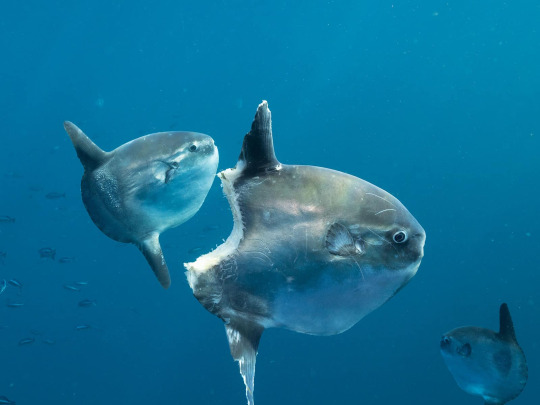
37K notes
·
View notes
Text
she
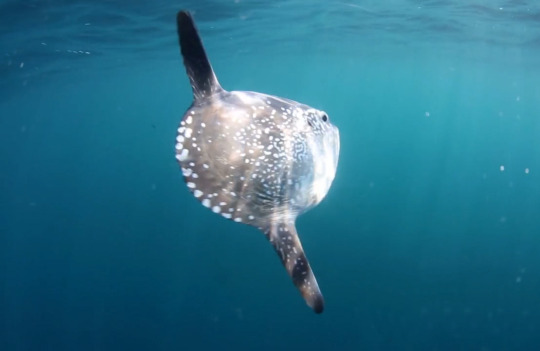
on my
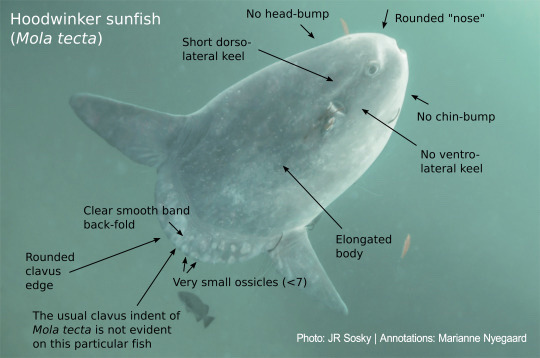
til i
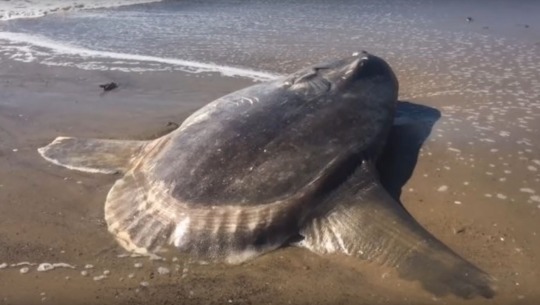
120 notes
·
View notes
Text
An ASCII overview of the Molidae fish family:
Common sunfish Mola mola |\ Σ  ̄ ̄\ Σ C ° 3 Σ ____/ |/
Bumphead sunfish Mola alexandrini |\ Σ  ̄ ̄) Σ C ° 3 Σ ___/ |/
Hoodwinker sunfish Mola tecta |\ Σ || ̄ ̄\ Σ= C ° 3 Σ ||____/ |/
Sharptail sunfish Masturus lanceolatus |\ Σ  ̄ ̄\ < C ° 3 Σ ____/ |/
Slender sunfish Ranzania laevis |\_______ ( •o• |/ ̄ ̄ ̄
#monterey bay aquarium#mola#molidae#mola mola#mola tecta#mola alexandrini#masturus lanceolatus#ranzania laevis#ocean sunfish#common sunfish#hoodwinker sunfish#bumphead sunfish#sharptail sunfish#slender sunfish#ascii me anything
10K notes
·
View notes
Photo

A conservationist examines a beached hoodwinker sunfish at Coal Oil Point Reserve in Santa Barbara, California. It is the first time this species has been seen in the northern hemisphere in 130 years
Photograph: Thomas Turner/UC Santa Barbara/AP
(via The week in wildlife – in pictures | Environment | The Guardian)
This individual was first reported on iNaturalist.
#Hoodwinker Sunfish#Mola tecta#Mola#Molidae#Tetraodontiformes#Actinopterygii#Osteichthyes#fish#sunfish#beach#citizen science#California
57 notes
·
View notes
Text
(you should definitely make a list of favorite fish)
I'm not super familiar with fish from the southwest Pacific, but here's some VERY brief reasarch:
New Zealand is home to 51 freshwater fish species, and about 1400 marine species. The region is a hotspot for marine biodiversity due to the wide range of environments, caused in large part by significant temperature differences between different regions of the country. Some personal favorite fish species from the region:
-New Zealand longfin eel (Anguilla dieffenbachii)
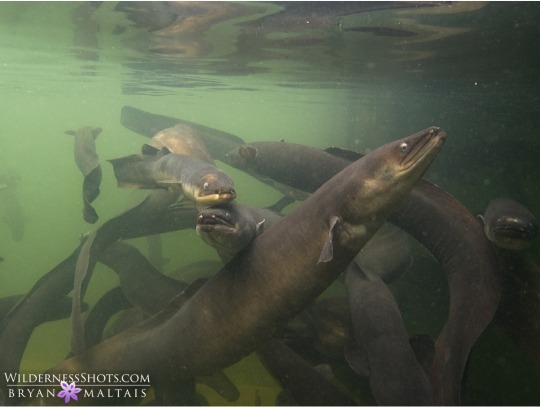
-Hoodwinker sunfish / Deep-sea giant sunfish (Mola tecta)

-Twister (Bellapiscis medius)

I included the articles I read below (both from the NZ government) if you want to do some further reading. Always good to see a new fish enthusiast!
And for a random fish: the chimaera!
Also called ghost sharks (they're not actually sharks), chimaera live in the deep sea and use sensory organs on their face to detect movement in lightless water. Their name supposedly comes from lines on their body making them look "stitched together".

sources:
https://www.doc.govt.nz/nature/native-animals/freshwater-fish/
https://www.doc.govt.nz/nature/habitats/marine/new-zealands-marine-biodiversity/
https://oceantoday.noaa.gov/creaturesofthedeep_chimaera/
I know nothing about fish.
I like fish for their aesthetics. I like fish because swimmy. I like fish because cute.
I like fish because HELL YEAH BROTHERRRR THAT'S A FUCKIN FISH.
I do not have a lot of fish trivia. I want to learn more fish trivia.
I know a lot about this one species of eel, so :D
If anyone wants to give me random fish trivia and infodump in my notes, I'm open for it :3
And if anyone can tell me about fish local to Oceania/the southwest Pacific/New Zealand then PLEASE.
I should make a list of my favourite fish.
#sorry if you knew this already#i promise I'm not trying to explain your country's geography to you (am american)#just want to help out a fellow fish fan and i think it is very cool that you want to learn about fish
43 notes
·
View notes